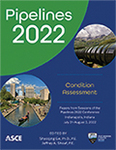Impact of Crown Crack Width in Load Carrying Capacity of Cementitious Spray Applied Pipe Linings
Publication: Pipelines 2022
ABSTRACT
Spray applied pipe lining (SAPL) is used by Departments of Transportation (DOTs) as a trenchless technology method to renew deteriorated gravity storm conduits and culverts. Cementitious SAPLs can increase the structural capacity of the deteriorated culverts. Previous studies have shown that the cementitious pipes are able to heal the hairline cracks (crack width of less than 0.01 in.). After crack formation, the healing process, also called autogenous healing, initiates by exposing the un-hydrated cementitious particles in the liner matrix to moisture. Currently, loads that generate 0.01-in. crack width is used as a benchmark for the liner thickness design. The goal of this paper is to measure the corresponding truck load that generates the 0.01 in. crack width on cementitious SAPL through a set of large-scale laboratory testing. To achieve this goal, three 60-in. diameter invert-deteriorated corrugated metal pipes (CMPs) were buried under 2 ft of soil cover in a soil box. Then, CMPs were renewed with cementitious SAPL and were subjected to the static vertical load using a hydraulic actuator. During the load application on the soil surface, the crown of the SAPLs were monitored by high resolution digital cameras, and the crack widths were measured using the digital image processing method. The results showed that thicker SAPL liner can resist larger amount of live load with lower crack opening width.
Get full access to this chapter
View all available purchase options and get full access to this chapter.
REFERENCES
ACPA. (2008). The infrastructure is collapsing. American Concrete Pipe Association.
Ahmadi, M., Hatami, M., Rahgozar, P., Shirkhanloo, S., Abed, S., Kamalzadeh, H., and Flood, I. (2020). “Development of an ESCO Risk Assessment Model as a Decision-Making Tool for the Energy Savings Certificates Market Regulator: A Case Study.” Applied Sciences, Multidisciplinary Digital Publishing Institute, 10(7), 2552.
Baharvand, S., and Laskar-Ara, B. (2021). “Hydraulic design criteria of the modified meander C-type fishway using the combined experimental and CFD models.” Ecological Engineering, Elsevier, 164, 106207.
Darabnoush Tehrani, A. (2016). Finite Element Analysis for ASTM C-76 Reinforced Concrete Pipes with Reduced Steel Cage. University of Texas at Arlington.
Darabnoush Tehrani, A. (2020). “Development of a Structural Design Methodology for Cementitious Sprayed Applied Pipe Linings in Gravity Storm Water Conveyance Conduits.”
Darabnoush Tehrani, A., Kohankar Kouchesfehani, Z., and Najafi, M. (2020a). “Pipe Profiling Using Digital Image Correlation.” Pipelines 2020, American Society of Civil Engineers, Reston, VA, 36–45.
Darabnoush Tehrani, A., Kohankar Kouchesfehani, Z., Najafi, M., Syar, J. E., and Kampbell, N. E. (2019). “Evaluation of Filling the Valleys of Corrugated Metal Pipes by Trenchless Spray Applied Pipe Linings.” Pipelines 2019: Multidisciplinary Topics, Utility Engineering, and Surveying, ASCE, Nashville, 84–94.
Darabnoush Tehrani, A., Kouchesfehani Kohankar, Z., and Najafi, M. (2020b). “Review and Recommendations for Structural Testing of Buried Gravity Storm Drain Pipes and Culverts.” Canadian Journal of Civil Engineering, (Soil–structure interaction of buried structures).
Kohankar Kouchesfehani, Z. (2020). “Development of a Structural Design Methodology for Polymeric Spray Applied Pipe Linings.”
Kouchesfehani Kohankar, Z., Darabnoush Tehrani, A., and Najafi, M. (2020). “Culvert Renewal with Cementitious/Geopolymer Spray Applied Pipe Lining: Field Data Collection and Assessment.” Journal of Pipeline Systems Engineering and Practice.
Najafi, M., Yu, X., Kouchesfehani, Z. K., Tehrani, A. D., Korky, S., Serajiantehrani, R., Raut, S., Kampbell, E., and Osborn, L. (2021). Structural Design Methodology for Spray Applied Pipe Liners in Gravity Storm Water Conveyance Conduits.
Yeau, K. Y., Sezen, H., and Fox, P. J. (2009). “Load Performance of In Situ Corrugated Steel Highway Culverts.” Journal of Performance of Constructed Facilities, 23(1), 32–39.
Information & Authors
Information
Published In
History
Published online: Jul 28, 2022
Authors
Metrics & Citations
Metrics
Citations
Download citation
If you have the appropriate software installed, you can download article citation data to the citation manager of your choice. Simply select your manager software from the list below and click Download.
